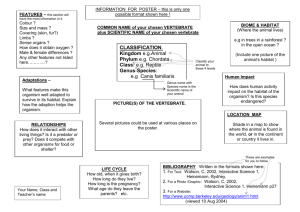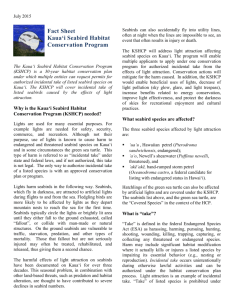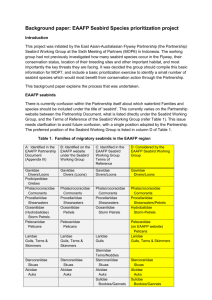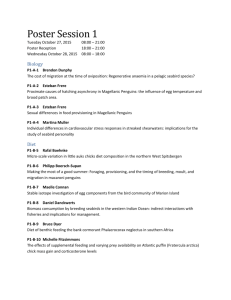Seabird Population Game (word)
advertisement
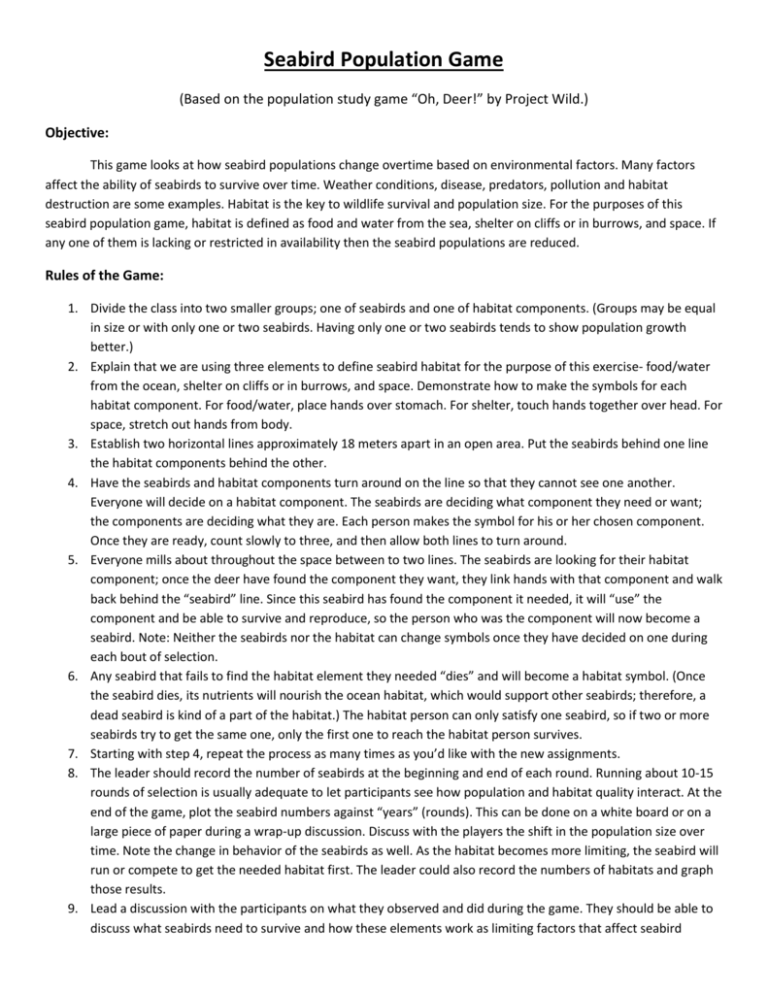
Seabird Population Game (Based on the population study game “Oh, Deer!” by Project Wild.) Objective: This game looks at how seabird populations change overtime based on environmental factors. Many factors affect the ability of seabirds to survive over time. Weather conditions, disease, predators, pollution and habitat destruction are some examples. Habitat is the key to wildlife survival and population size. For the purposes of this seabird population game, habitat is defined as food and water from the sea, shelter on cliffs or in burrows, and space. If any one of them is lacking or restricted in availability then the seabird populations are reduced. Rules of the Game: 1. Divide the class into two smaller groups; one of seabirds and one of habitat components. (Groups may be equal in size or with only one or two seabirds. Having only one or two seabirds tends to show population growth better.) 2. Explain that we are using three elements to define seabird habitat for the purpose of this exercise- food/water from the ocean, shelter on cliffs or in burrows, and space. Demonstrate how to make the symbols for each habitat component. For food/water, place hands over stomach. For shelter, touch hands together over head. For space, stretch out hands from body. 3. Establish two horizontal lines approximately 18 meters apart in an open area. Put the seabirds behind one line the habitat components behind the other. 4. Have the seabirds and habitat components turn around on the line so that they cannot see one another. Everyone will decide on a habitat component. The seabirds are deciding what component they need or want; the components are deciding what they are. Each person makes the symbol for his or her chosen component. Once they are ready, count slowly to three, and then allow both lines to turn around. 5. Everyone mills about throughout the space between to two lines. The seabirds are looking for their habitat component; once the deer have found the component they want, they link hands with that component and walk back behind the “seabird” line. Since this seabird has found the component it needed, it will “use” the component and be able to survive and reproduce, so the person who was the component will now become a seabird. Note: Neither the seabirds nor the habitat can change symbols once they have decided on one during each bout of selection. 6. Any seabird that fails to find the habitat element they needed “dies” and will become a habitat symbol. (Once the seabird dies, its nutrients will nourish the ocean habitat, which would support other seabirds; therefore, a dead seabird is kind of a part of the habitat.) The habitat person can only satisfy one seabird, so if two or more seabirds try to get the same one, only the first one to reach the habitat person survives. 7. Starting with step 4, repeat the process as many times as you’d like with the new assignments. 8. The leader should record the number of seabirds at the beginning and end of each round. Running about 10-15 rounds of selection is usually adequate to let participants see how population and habitat quality interact. At the end of the game, plot the seabird numbers against “years” (rounds). This can be done on a white board or on a large piece of paper during a wrap-up discussion. Discuss with the players the shift in the population size over time. Note the change in behavior of the seabirds as well. As the habitat becomes more limiting, the seabird will run or compete to get the needed habitat first. The leader could also record the numbers of habitats and graph those results. 9. Lead a discussion with the participants on what they observed and did during the game. They should be able to discuss what seabirds need to survive and how these elements work as limiting factors that affect seabird survival. They should recognize that the habitat and the population are both dynamic. Finally, they should be able to recognize the increasing competition by the seabirds and the stress that places on them. 10. If desired, run a few rounds with “invasive species” or “marine debris” as mortality factors. Discuss some of the invasive species impacting seabirds (rats, fox, etc.) and how marine debris can harm seabirds. Play a few rounds with 2-4 students playing the following roles: Marine Debris- Before a round is played and the seabirds and habitat components are facing away from each other, choose 3-4 players from the habitat side to be marine the debris, do not let the seabirds see! During the round, the “marine debris” will act just like a habitat component and be food, shelter or space. Seabirds usually cannot tell the difference between natural food/habitat and trash. Once the round is over and all of the remaining habitat and seabirds are back in place, reveal the players that were marine debris. The seabirds that chose those players “die” and go back to the habitat side. Invasive Species- Before this round starts, pull 2-3 players from the habitat side and have them become invasive species. Line them up similar to the diagram below: Invasive Species Seabirds Habitat When the instructor says “go” the seabirds will try to catch their chosen habitat component. During this time, the invasive species are predators that will try to “eat” as many seabirds as possible. If a seabird is tagged by an invasive species, it dies and becomes habitat. Once a seabird has gotten their habitat component, they are safe from the invasive species. Play a few rounds this way. Discuss how the invasive species impact the seabird population. References: This game was adapted from “Oh, Deer,” a Project WILD activity. Project WILD is a national environmental education program developed by the Western Regional Environmental Education Council. "Classroom Activity: Population Study Game (Oh, Deer!)." RIVERVENTURE. Web. 14 Apr. 2015. <http://www.riverventure.org/charleston/resources/pdf/population study game.pdf>.







